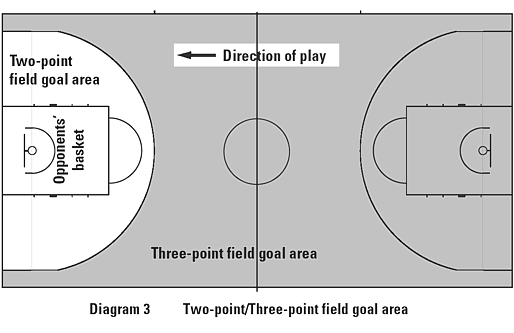
In basketball, a player can shoot either a 2-point shot or 3-point shot. Each 3-point shot made generates one extra point compared to a 2-point shot made. But it’s also more difficult to make a 3-point shot than a 2-point shot.
So how do you measure the tradeoff and find the right balance?
I first pondered about this problem a few years ago, and when I finally decided to write about it (today), I was amazed at the simplicity of the answer. The answer can be found in a simple mathematical formula.
![]()
![]() : field goal percentage of 2-point shots
: field goal percentage of 2-point shots
![]() : field goal percentage of 3-point shots.
: field goal percentage of 3-point shots.
Rearranging the above equation renders the following two formulas:
![]()
![]()
This means that ![]() can be only two-thirds of
can be only two-thirds of ![]() and still be equally effective in producing the same number of points. Conversely,
and still be equally effective in producing the same number of points. Conversely, ![]() has to be 50% higher than
has to be 50% higher than ![]() in order to be equally effective for points production.
in order to be equally effective for points production.
This sort of “conversion” can be helpful for several reasons. For one, it puts things into perspective. Stephen Curry, one of the best shooters in the NBA right now, recorded 45.4% 3-point FGP in the 2015-2016 season. (That means he made 45.4% of the 3-point shots he attempted.) How good is 45.4% 3-point FGP?
Using the conversion formula above, we calculate that figure has the same effectiveness as 68.1% 2-point FGP. In other words, in order to produce the same number of points Stephen Curry produced from his 3-pointers, Player X taking the same number of shots would have had to make 68.1% of the 2-point shots he attempted.
If you ever played or watched basketball, you would know how difficult that is. It truly gives an idea how great of a shooter Stephen Curry is.
But more importantly, this sort of calculation can recommend coaches, players, and teams whether shooting more 3-point shots will benefit their team by maximizing the scoring. The calculations are similar to how businessmen and investors would calculate their return-on-investment (ROI).
![]()
In our case of basketball, the formula looks like this:
![]()
![]()
Let’s see an example. A team has 50% chance of making a 2-point shot (50% 2-pointer FGP) and 40% chance of making a 3-point shot (40% 3-pointer FGP). We can calculate the expected return value for each shot taken like the following.
![]()
![]()
This means that, for 2-point shots, we can expect 1 point generated from each shot attempt. Whereas, for 3-point shots, we can expect 1.2 points generated from each shot attempt.
As we can see, average expected return for shooting 3-point shots is higher than that of shooting 2-point shots, even though there is a lower chance of a 3-point shot going in than for a 2-point shot.
With that said, the average 2-point FGP for all NBA regular season games from 1995 to 2016 was 48% while the average 3-point FGP was 35%.
So you decide: Is taking more 3-point shots worth the benefit?

